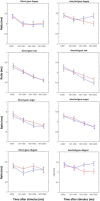Multimodal Evidence of Atypical Processing of Eye Gaze and Facial Emotion in Children With Autistic Traits
- PMID: 35242018
- PMCID: PMC8886727
- DOI: 10.3389/fnhum.2022.733852
Multimodal Evidence of Atypical Processing of Eye Gaze and Facial Emotion in Children With Autistic Traits
Abstract
According to the shared signal hypothesis (SSH) the impact of facial expressions on emotion processing partially depends on whether the gaze is directed toward or away from the observer. In autism spectrum disorder (ASD) several aspects of face processing have been found to be atypical, including attention to eye gaze and the identification of emotional expressions. However, there is little research on how gaze direction affects emotional expression processing in typically developing (TD) individuals and in those with ASD. This question is investigated here in two multimodal experiments. Experiment 1 required processing eye gaze direction while faces differed in emotional expression. Forty-seven children (aged 9-12 years) participated. Their Autism Diagnostic Observation Schedule (ADOS) scores ranged from 0 to 6 in the experiment. Event-related potentials (ERPs) were sensitive to gaze direction and emotion, but emotion processing did not depend on gaze direction. However, for angry faces the gaze direction effect on the N170 amplitude, as typically observed in TD individuals, diminished with increasing ADOS score. For neutral expressions this correlation was not significant. Experiment 2 required explicit emotion classifications in a facial emotion composite task while eye gaze was manipulated incidentally. A group of 22 children with ASD was compared to a propensity score-matched group of TD children (mean age = 13 years). The same comparison was carried out for a subgroup of nine children with ASD who were less trained in social cognition, according to clinician's report. The ASD group performed overall worse in emotion recognition than the TD group, independently of emotion or gaze direction. However, for disgust expressions, eye tracking data revealed that TD children fixated relatively longer on the eyes of the stimulus face with a direct gaze as compared with averted gaze. In children with ASD we observed no such modulation of fixation behavior as a function of gaze direction. Overall, the present findings from ERPs and eye tracking confirm the hypothesis of an impaired sensitivity to gaze direction in children with ASD or elevated autistic traits, at least for specific emotions. Therefore, we conclude that multimodal investigations of the interaction between emotional processing and stimulus gaze direction are promising to understand the characteristics of individuals differing along the autism trait dimension.
Keywords: ADOS; EPN; N170; autism spectrum disorder; emotion processing; face recognition; gaze direction.
Copyright © 2022 Bagherzadeh-Azbari, Lau, Ouyang, Zhou, Hildebrandt, Sommer and Lui.
Conflict of interest statement
The authors declare that the research was conducted in the absence of any commercial or financial relationships that could be construed as a potential conflict of interest.
Figures








Similar articles
-
Memory for facial expressions on the autism spectrum: The influence of gaze direction and type of expression.Autism Res. 2022 May;15(5):870-880. doi: 10.1002/aur.2682. Epub 2022 Feb 12. Autism Res. 2022. PMID: 35150078
-
Gaze behavior, facial emotion processing, and neural underpinnings: A comparison of adolescents with autism spectrum disorder and conduct disorder.J Child Psychol Psychiatry. 2025 May 26. doi: 10.1111/jcpp.14172. Online ahead of print. J Child Psychol Psychiatry. 2025. PMID: 40420478
-
The impact of emotional facial expressions on reflexive attention depends on the aim of dynamic gaze changes: An ERP study.Psychophysiology. 2023 Apr;60(4):e14202. doi: 10.1111/psyp.14202. Epub 2022 Nov 4. Psychophysiology. 2023. PMID: 36331096
-
Investigating automatic emotion processing in boys with autism via eye tracking and facial mimicry recordings.Autism Res. 2021 Jul;14(7):1404-1420. doi: 10.1002/aur.2490. Epub 2021 Mar 11. Autism Res. 2021. PMID: 33704930
-
Neural bases of eye and gaze processing: the core of social cognition.Neurosci Biobehav Rev. 2009 Jun;33(6):843-63. doi: 10.1016/j.neubiorev.2009.02.004. Epub 2009 Feb 24. Neurosci Biobehav Rev. 2009. PMID: 19428496 Free PMC article. Review.
Cited by
-
Emotion recognition deficits in children and adolescents with autism spectrum disorder: a comprehensive meta-analysis of accuracy and response time.Front Child Adolesc Psychiatry. 2025 Jan 14;3:1520854. doi: 10.3389/frcha.2024.1520854. eCollection 2024. Front Child Adolesc Psychiatry. 2025. PMID: 39877703 Free PMC article.
-
The effects of face masks on emotional appraisal ability of students with autism spectrum disorder.Int J Dev Disabil. 2023 Mar 27;70(8):1532-1540. doi: 10.1080/20473869.2023.2189765. eCollection 2024. Int J Dev Disabil. 2023. PMID: 39713506 Free PMC article.
References
-
- American Psychiatric Association (2013). Diagnostic and statistical manual of mental disorders, 5th Edn. Virginia: APA, 10.1176/appi.books.9780890425596.744053 - DOI
LinkOut - more resources
Full Text Sources

